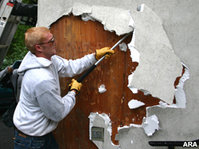
| (ARA) – Tune in to your average home improvement show and you may get the idea that anyone can do demolition. Think again. |
| Virtually every home remodeling project begins with demolition. Homeowners who do their own demo can save big bucks, especially on projects where professionals will finish the construction part of the job. But poorly executed demolition can damage parts of your home that you’d rather preserve – and end up costing you more than the remodeling project itself “There’s more to demolition than picking up a sledgehammer and swinging at the wall,” says Joe Skach, a demolition specialist and inventor of a pry bar system commonly used by contractors for demolition. “You need to know what to remove and how to remove it properly in order to keep the structures that you’ll need in place to complete your renovation.” Before you tear up a floor, open a wall or demolish a countertop, keep these basic do-it-yourself demolition tips in mind: * When removing siding from a home exterior, be aware of all lines coming into the house through the siding. Take care in these areas so that you don’t damage the home’s power source or leave yourself without cable or phone service. If you’re using a ladder to remove siding from high on the building or just getting on to the roof be sure the ladder contacts the top of the structure at least two steps below the ladder’s topmost step. If possible, tie the ladder to a stable surface near the upper support point. * If you’re opening drywall, make sure you know whether there are live electrical wires, pipes or HVAC conduits behind it. Turn off power and water before beginning. Cutting into wiring or pipes can cause serious injury to you and seriously damage your house. * Before you do anything with a wall, head to the basement or attic to determine if it’s load-bearing – meaning the wall helps support the ceiling or roof above it and is integral to the structural integrity of the house. To determine if a wall is load-bearing, look at the exposed joists in the cellar or attic. If joists are perpendicular to the wall, it’s likely load-bearing. * Be prepared to be surprised. Floors can have multiple layers of covering, roofs can have multiple layers of shingles, walls can turn out to be load-bearing and newly revealed pipes can spring a leak. Allow room in your budget and schedule to deal with the unexpected. * The right tools will make your job much easier. Professional contractors know it’s hard to remove hardwood floor with a putty knife or take down a wall with a tack hammer. You shouldn’t try it either. Before you begin your demolition project, be sure you have the right tools on hand. While working on a six-month construction job and struggling with inefficient prying devices, Skach invented the Artillery Pry Bar System. Designed to tackle many jobs that require both prying power and adaptability, the tool features a variety of interchangeable prying blades and handles that fit onto a light yet strong extruded aluminum body. “I found the ability to adjust the length and weight of the handles made prying much easier and far less of a strain on the body,” says homeowner Norman Novinger, who used the Artillery Pry Bar System to remove tile from a kitchen, bath and walkway. The first 16 square feet of the job took two and a half hours with traditional prying tools. Novinger says he accomplished the remaining 200 square feet in just one hour using Skach’s invention. The system is especially effective on siding, flooring and roofing materials. First used by contractors and landlords, the system is now offered in a homeowners’ version. * Cover up and clean up. Protect your eyes with safety goggles and your lungs with a dust mask or respirator. Flying particles can cause serious injury. Inhaled insulation or lead paint dust can create respiratory illness. For most projects of moderate to grand scope, it’s wise to invest in a dumpster. Remove construction debris quickly as you progress to keep your work area safe and efficient. “Do-it-yourself demolition can be both satisfying and a money-saver for homeowners, whether they finish the project themselves or hand off the construction phase to professionals,” Skach says. “The key is to do demo right – with the right tools – so that every swing of a hammer and pry with a bar is as easy and effective as possible.” Courtesy of ARAcontent |











